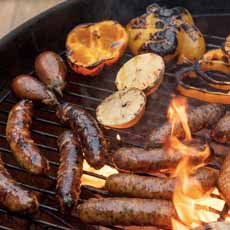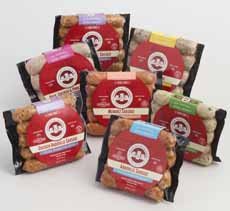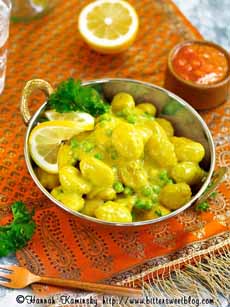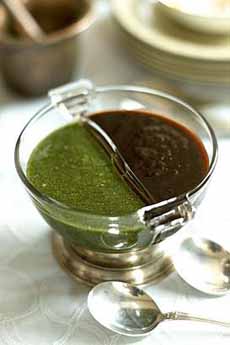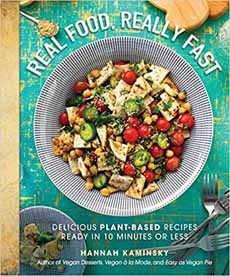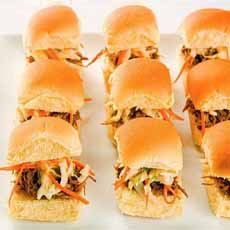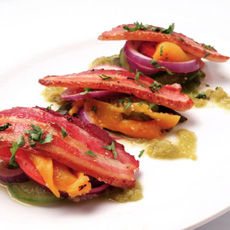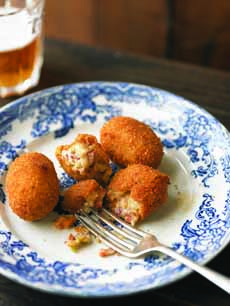|
For holiday weekends or cookouts, most of us pick up cole slaw at the grocery store.
This commercial slaw generally consists of cabbage, mayonnaise thinned with vinegar, and a few shreds of carrot for color. It may be tangy and crunchy, but it can be so much more flavorful.
Here’s how to fix up store-bought cole slaw and other salads: chicken, egg, macaroni, potato, etc.
Or, choose one of the nine recipes below, from Asian-accented slaws to bacon and blue cheese.
COLE SLAW HISTORY: WHAT’S A SLAW & WHY IS IT “COLE?”
A little “slaw” history:
Slaw is a salad consisting primarily of shredded raw white cabbage. Its origin goes back to ancient Roman times, when the cabbage was mixed with vinegar. Mayonnaise didn’t appear until the 18th century (mayonnaise history).
Coleslaw, also spelled cole slaw, originates from the Latin colis, cabbage.
Cabbage was easy to grow and a mainstay of the diet of the poor (who, it should be said, represented most of the population). It also was easy to store and had a long shelf life. No doubt, many European families dined on chopped cabbage salad.
Enter the Dutch. “Slaw” comes from a variation of the Dutch sla; koolsalade, or cabbage salad, shortened to koolsla. Cabbage, “kool,” is pronounced “cole.”
Dutch travelers to the New World made koolsla with local cabbage. Instead of being torn into bite-size pieces like lettuce salad, the cabbage was thinly sliced or shredded. “Sla” is short for “salade.”
In English, “slaw” came to specify a salad of shredded vegetables. Over time, shredded cabbage slaw was joined by carrot slaw and more recently, broccoli slaw and shaved Brussels sprouts slaw.
The term got anglicized in the 18th century as cole slaw (and sometimes, cold slaw).
Today in the U.S., cole slaw is a shredded cabbage salad with a mayonnaise-based dressing, often with a shredded carrot. It can be made with red cabbage for more pizzazz, as in today’s recipe; but few people do so.
Some people add fruits: diced mango or pineapple, raisins, sliced grapes, etc. We didn’t use them in the recipe because of the peanut dressing; but you can easily add dried cherries, raisins, or other dried fruits.
Coleslaw can be dressed with vinaigrette or mayonnaise. Some regional American recipes use mustard.
RECIPE: THAI-ACCENTED COLE SLAW
This recipe for Thai-accented cole slaw is adapted from Beekman 1802. Thai ingredients like peanut butter, peanuts, ginger, and soy sauce add flair; and the Thai-style dressing replaces the mayonnaise.
Prep time is 15 minutes, and cook time for the dressing is 6 minutes.
Ingredients
1 pound red cabbage, coarsely shredded (about 5 cups)
2 cups coarsely chopped basil
1/3 cup finely diced cubano pepper
For The Dressing
2 tablespoons sesame seeds, preferably toasted
2 teaspoons sesame oil
1/3 cup peanut butter
5 tablespoons apple cider vinegar
1 tablespoon ginger honey
2 teaspoons fresh grated ginger
3 tablespoon soy sauce
1 teaspoon grated horseradish
1/4 cup white wine
Optional garnish: chopped salted or honey-roasted peanuts
|
|

[1] Red cabbage slaw with Thai accents. The recipe is below (photo courtesy Beekman 1802).

[2] Red, white and blue cole slaw. The blue is blue cheese (photo courtesy Eat Wisconsin Cheese).
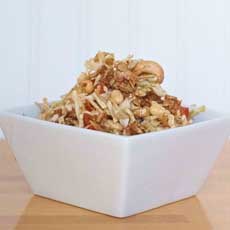
[3] Peanut cole slaw with granola (photo courtesy Nuts For Granola).
 [4] Spicy Thai cole slaw (photo courtesy A Communal Table) [4] Spicy Thai cole slaw (photo courtesy A Communal Table)
|






